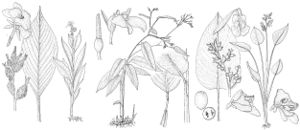Cannaceae
Herbs, perennial, from rhizomes. Aerial stems present, unbranched. Leaves cauline, 2-ranked, differentiated into basal sheath, petiole, and blade; sheaths overlapping, supporting stem, open, ligule absent; summit of petiole not differentiated; blade with lateral veins parallel, diverging from prominent midrib. Inflorescences 1 per aerial shoot, terminal on leafy shoot, pedunculate racemes or panicles of flowers or of 2-flowered monochasial cymes (cincinni); bracts of main axis subtending flowers or cincinni. Flowers bisexual, asymmetric; sepals and petals differentiated, sepals 3, distinct, petals 3, connate at base; fertile stamens 1, petal-like, anther marginal, 1-locular; staminodes (1–)3–4, petal-like, showy, unequal, anterior staminode (labellum) often broader than posterior staminodes; ovary inferior, 3-carpellate, 3-locular, all locules fertile; placentation axile; ovules few to numerous per locule; style standing away from stamens and staminode, petal-like; stigmatic area shaped as marginal callosity; style, stamen, and staminodes basally connate into tube. Fruits capsules; sepals persistent in fruit. Seeds: aril absent; endosperm scanty; perisperm copious; embryo straight. x = 9.
Distribution
Tropical and subtropical, primarily the Americas.
Discussion
The flowers of Cannaceae are showy and brightly colored with foliaceous or petal-like sepals and have a conspicuously warty or spiny-fimbriate ovary. The fruits are large, broadly ellipsoid, loculicidal, and warty or spiny-fimbriate. The seeds are very hard with an ovoid to globose shape.
Cannaceae are most closely related to the Marantaceae, the prayer-plants, with which they share several unusual reproductive features, such as asymmetric flowers, a reduction in the number of pollen-bearing stamens to a single bisporangiate anther, and secondary pollen presentation (P. F. Yeo 1993). The pollen grains are large and spheroid, and, like those of most members of the order Zingiberales, have a much reduced exine and a much expanded intine layer.
Cannaceae are known from several dubious fossils of vegetative organs dating to the late Cretaceous. The seeds are exceptionally hard and durable: a seed reported to be 600 years old and preserved in a South American archeological tomb germinated and flowered (J. C. Lerman and E. M. Cigliano 1971); yet, no fossilized seeds have been discovered.
Cannaceae are native to the American tropics and subtropics, occurring from sea level to mountainous slopes below 3000 m. One species (Canna indica) has become naturalized throughout the Asian and African tropics and subtropics, and several species and hybrids are commonly cultivated in the gardens of Europe, North America, and tropical zones. Cannas are found scattered in transitional habitats, both natural and artificial. In the wild, they grow along the edges of marshes and forest margins, often in water to 10 cm deep. They also thrive in roadside ditches and refuse sites, given adequate moisture.
Genus Genera 1, species 10 (3 species in the flora).
